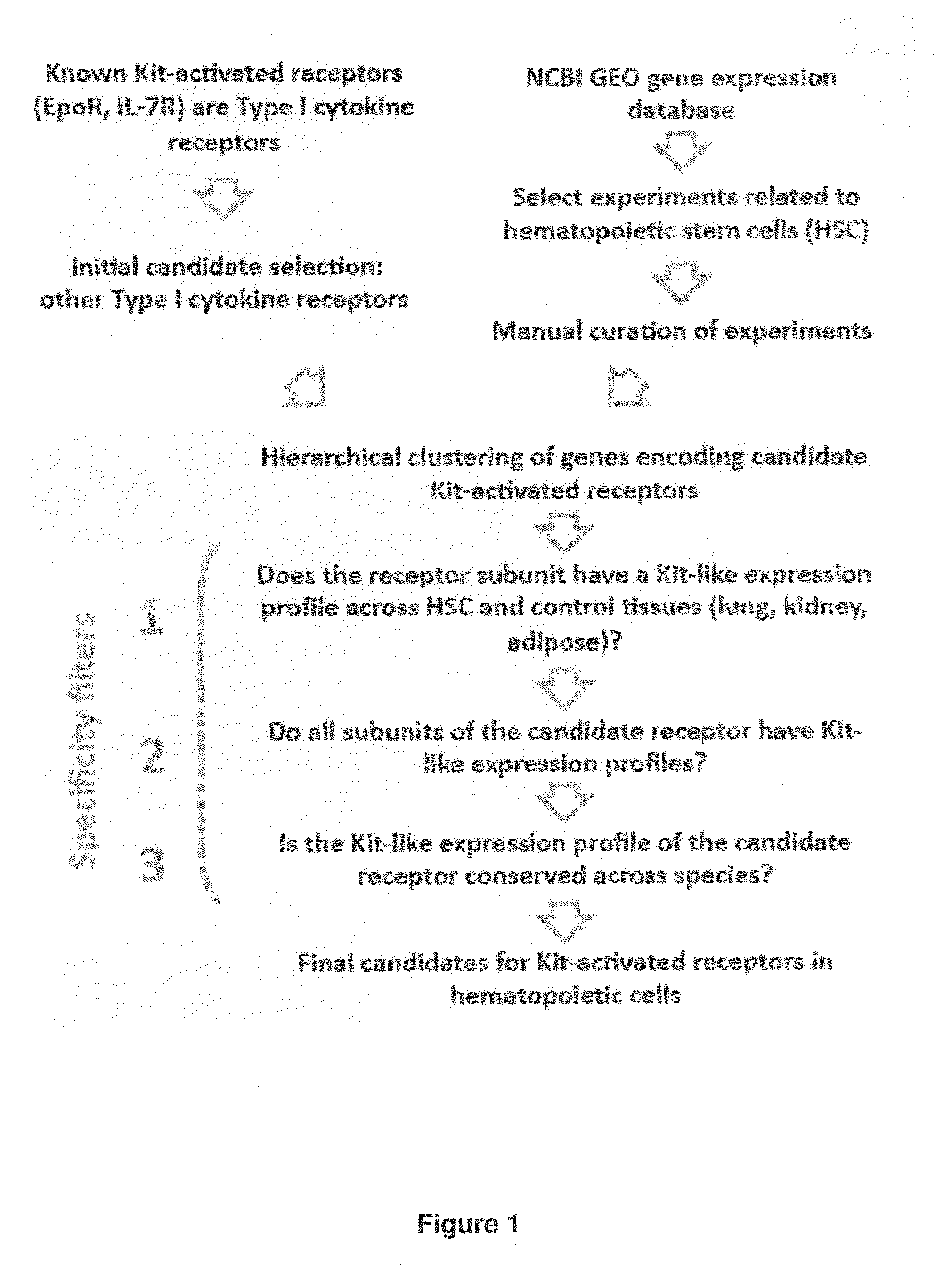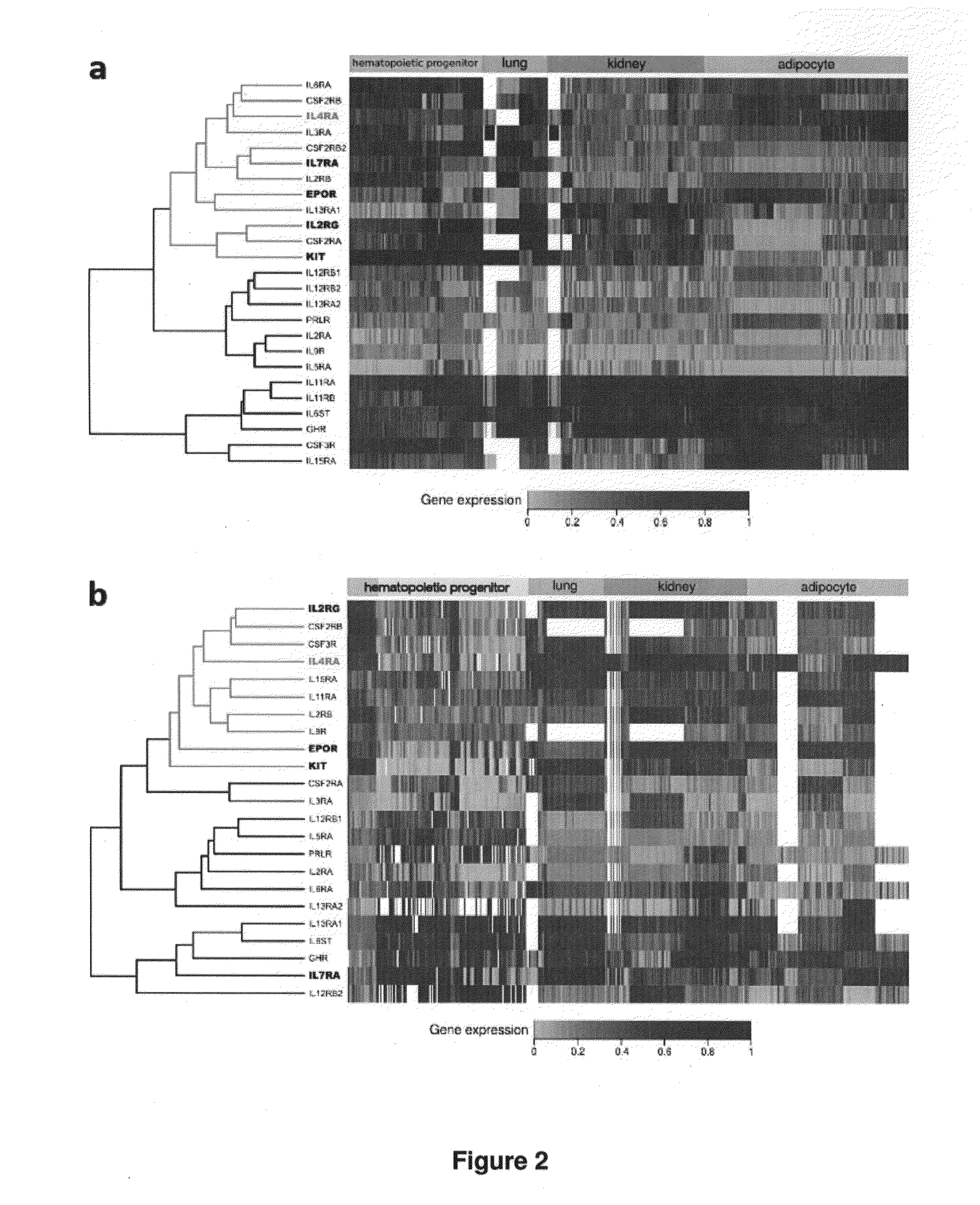Modulation of kit signaling and hematopoietic cell development by IL-4 receptor modulation
a technology of il-4 receptor and kit signaling, which is applied in the field of kit signaling and hematopoietic cell development by il4 receptor modulation, can solve the problems of esc survival and differentiation capacity defects, the scope of approaches to discover signal transduction interactions is particularly limited, and the kit signaling is reduced. , the effect of reducing the number of lymphocytes in the individual
- Summary
- Abstract
- Description
- Claims
- Application Information
AI Technical Summary
Benefits of technology
Problems solved by technology
Method used
Image
Examples
example 1
[0094]There is functional evidence of synergy in vivo between Kit and Type I cytokine receptor pathways (Duarte, R. F. & Franf, D. A. Leuk Lymphoma 43, 1179-1187 (2002); Sui, X. et al. Blood 92, 1142-1149 (1998)). Biochemical data suggests that the mechanism for synergy involves direct interaction of the Type I cytokine receptors EpoR and IL-7R with activated Kit (Jahn, T. et al. Blood 110, 1840-1847 (2007) Wu, H. et al. Nature 377, 242-246 (1995)). The interactions between Kit and these Type I cytokine receptors are functionally important, as illustrated by experiments demonstrating synergistic effects of the loss of function of Kit and γc, a subunit of IL-7R (Rodewald, H. R. et al. Immunity 6, 265-272 (1997)). We set out to identify novel interactions between Kit and other receptors in hematopoietic cells. For this purpose, a bioinformatics approach called Co-expressed RNA for Signal Transduction Elucidation, or CORSiTE, was developed that analyzes gene expression data from vast, ...
example 2
[0124]Previously, IL-4R− / − mice were shown to have increased resistance to Leishmania major infection, impaired alternative macrophage activation, progressive weight loss begins 6 weeks after S. mansoni infection, liver inflammation, liver fibrosis, increased levels of IgG2 in response to N. brasiliensis infection, lower circulating levels of IgE, lower circulating levels of IgE, impaired II-4 induced CD4+ T cell proliferation, increased IgE levels, airway hyperresponsiveness to methacholine, decreased persistence of Th2 cells as indicated by II-4, II-5, and II-13 production, progressive weight loss begins 6 weeks and increased mortality after S. mansoni infection, airway inflammation following chronic allergen challenge, and increased in eosinophils and monocytes found in lung parenchyma.
[0125]The representation of different hematopoietic cell types in IL-4R deficient mice was analyzed. As demonstrated in FIG. 6, by 5-6 weeks of age, elevated numbers of erythrocytes, myeloid-lineag...
PUM
| Property | Measurement | Unit |
|---|---|---|
| Volume | aaaaa | aaaaa |
| Volume | aaaaa | aaaaa |
| Volume | aaaaa | aaaaa |
Abstract
Description
Claims
Application Information
 Login to View More
Login to View More - R&D
- Intellectual Property
- Life Sciences
- Materials
- Tech Scout
- Unparalleled Data Quality
- Higher Quality Content
- 60% Fewer Hallucinations
Browse by: Latest US Patents, China's latest patents, Technical Efficacy Thesaurus, Application Domain, Technology Topic, Popular Technical Reports.
© 2025 PatSnap. All rights reserved.Legal|Privacy policy|Modern Slavery Act Transparency Statement|Sitemap|About US| Contact US: help@patsnap.com



